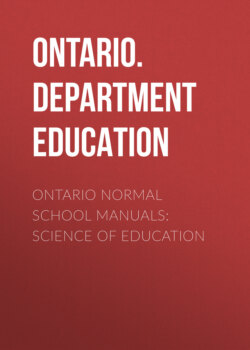Читать книгу Ontario Normal School Manuals: Science of Education - Ontario. Department of Education - Страница 48
PUPIL'S MOTIVE
ОглавлениеPupil's Problem versus Teacher's.—But it is important that the problem before the pupil at the beginning of the lesson should really be the pupil's and not the teacher's merely. The teacher should be careful not to impose the problem on the pupils in an arbitrary way, but should try to connect the lesson with an interest that is already active. The teacher's motive in teaching the lesson and the pupil's motive in attending to it are usually quite different. The teacher's problem should, of course, be identical with the real problem of the lesson. Thus in a literature lesson on "Hide and Seek" (Ontario Third Reader), the teacher's motive would be to lead the pupil to appreciate the music of the lines, the beauty of the images, and the pathos of the ideas; and in general, to increase the pupil's capacities of constructive imagination and artistic appreciation. The pupil's motive might be to find out how the poet had described a familiar game. In a nature study lesson on "The Rabbit," the teacher's motive would be to lead the pupil to make certain observations and draw certain inferences and thus add something to his facility in observation and inference. The pupil's motive in the same lesson would be to discover something new about a very interesting animal. In general, the teacher's motive will be (1) to give the pupil a certain kind of useful knowledge; (2) to develop and strengthen certain organs; or (3) to add something to his mechanical skill by the forming of habitual reactions. In general, the pupil's motive will be to learn some fact, to satisfy some instinct, or perform some activity that is interesting either in itself or because of its relation to some desired end. That is, the pupil's motive is the satisfaction of an interest or the promotion of a purpose.
Pupil's Motive May Be Indirect.—It is evident from the foregoing that the pupil's motive for applying himself to any lesson may differ from the real lesson problem, or motive. For instance, in mastering the reading of a certain selection, the pupil's chief motive in applying himself to this particular task may be to please and win the approbation of the teacher. The true lesson problem, however, is to enable the learner to give expression to the thoughts and feelings of the author. When the aim, or motive, is thus somewhat disconnected from the lesson problem itself, it becomes an indirect motive. While such indirect motives are undoubtedly valuable and must often be used with young children, it is evident that when the pupil's motive is more or less directly associated with the real problem of the lesson, it will form a better centre for the selecting and organizing of the ideas entering into the new experience.
Relation to Pupil's Feeling.—A chief essential in connection with the pupil's motive, or attitude, toward the lesson problem, is that the child should feel a value in the problem. That is, his apprehension of the problem should carry with it a desire to secure a complete mastery of the problem from a sense of its intrinsic value. The difference in feeling which a pupil may have toward the worth of a problem would be noticed by comparing the attitude of a class in the study of a military biography or a pioneer adventure taken from Canadian or United States sources respectively. In the case of the former, the feeling of patriotism associated with the lesson problem will give it a value for the pupils entirely absent from the other topic. The extent to which the pupil feels such a value in the lesson topic will in most cases also measure the degree of control he obtains over the new experience.
